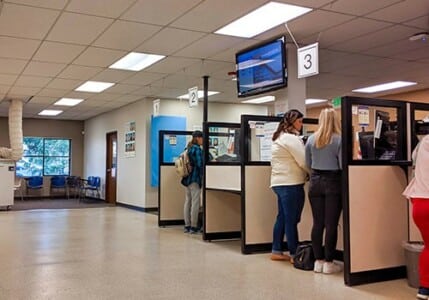
If you are a driver in the United States, it is important to know how to check if your license is suspended. There are a few different ways to do this, and we will outline four of them in this article. By following these simple steps, you can alleviate any concerns and take the necessary steps to get your license back if it is, in fact, suspended.
Table of Contents
4 Easy Ways To Check If Your License Is Suspended

Depending on the laws of the state you are governed by, there are four major ways to check the state of your license:
#1. Online DMV Portal
You can find out if your license has been suspended from the comfort of your home. All states have a dedicated Department of Motor Vehicles (DMV) website where you can access driver services and vehicle information through an online portal. (Remember: State-official websites have .gov extensions at the end of the domain.)
Your online portal will allow you to access driving records, manage vehicle tags and titles, and verify driving privileges. To create an account, you will need to provide your:
- Email address
- Date of birth
- Last four digits of your social security number
- Other details on your issued driver’s license/learner’s permit/identification card
Once you have created your account, you can confirm your license status by clicking on My License, Permit, or Services. This procedure is generally the same across all state DMV portals. In some cases, you may need to pay a fee to view your license status. For example, in California, you have to pay $2.00 to access and download your driver’s record.
You can also follow the steps below to verify your driving privileges:
- Navigate to your state’s Department of Motor Vehicles website.
- In the header menu, look for a link that says “Check The Status Of Your Driver’s License.” Click on it.
- A new page will open with a form that asks for your driver’s license number, last name, and date of birth. Fill out this information and hit submit.
- The next page will show the status of your driver’s license, whether it is valid, suspended, revoked, or canceled.
#2. Visit A Local DMV Office
If you want to verify the status of your driver’s license in person, you can do so by visiting your local DMV office. You will need to provide your driver’s license number, date of birth, and other personal information. The DMV clerk can usually tell you why your license is suspended and what you need to do to get it back.
#3. Contact Your State DMV By Mail
When your driver’s license is suspended, it can be difficult to figure out what to do next. One way to check the status of your license is to contact your state DMV by mail. You can print out the appropriate form and send it with a request letter to your local DMV office. Make sure you have confirmed the correct address before mailing anything, as there may be a higher fee for mail inquiries.
#4. Order A Copy Of Your Driving Record
It can be difficult to figure out what to do if your driver’s license is suspended. One way to check the status of your license is to order a copy of your driving record. This is the most official way to check if your license has been suspended, and it can be used for job interviews or court hearings. To order a copy, you can either call your local DMV office and pay the fee with a credit card, or print out the form from the DMV website and send it in with a check. You should expect to receive the driving record within 10-14 business days.
Other Driver Record Information Available
You can gain many other advantages from opening a DMV account besides checking your driving eligibility. Your DMV account can become your go-to method for all necessary information regarding your vehicle. You can renew your vehicle registration, order your driving history, confirm your CDL Status, request a new license, change your address, and more.
The DMV also allows you to restore your revoked license online. In addition, you can renew or replace your license or non-driver ID and registration.
On the other hand, your driving record also gives you access to other pieces of information you may need as well, such as:
- Driver license number, classification, status, and expiration date
- Points, suspensions, fines, DUIs, and revocations
- Traffic violations and convictions, such as speeding citations and traffic tickets
- Number of accidents
Penalties For Driving With A Suspended License

The consequences for driving with a suspended license vary depending on the state you live in. Typically, unlicensed driving is a misdemeanor or infraction and results in a fine of $25-$200. However, if you are caught driving with a suspended or revoked license, you may be charged with a felony or misdemeanor and face harsher penalties, such as jail time or fines. Be sure to check your state’s laws to see what the specific penalties are.
Some drivers have received penalties for driving with a suspended license, such as jail time or fines. For example, a driver in Florida was sentenced to 60 days in jail after being caught driving with a suspended license. In another case, a driver in Texas was fined $2,000 for driving with a suspended license.
The Bottom Line
There are four easy ways to check if your license is suspended; checking online, contacting the DMV, speaking with a lawyer, and getting a copy of your driving record. If you are worried that your license may be suspended for any reason, it is important to take the necessary steps to find out for sure. Depending on the state you live in, the consequences of driving with a suspended license can vary, from fines to jail time.
When fighting to get your driver’s license back to good standing again, you may face different obstacles depending on your situation. One common obstacle is a background check. If you have any criminal convictions on your record, this may prevent the DMV from reinstating your license. In addition, you may be required to take a driving test or complete a driver’s education course before the DMV considers reinstating your license.
Frequently Asked Questions (FAQs)
Does the DMV keep records of the last time I was convicted of a speeding ticket?
Yes, the DMV keeps records of the last time you were convicted of a speeding ticket. This information is recorded on your driving record, which is a document that details your driving history. You can access your driving record by visiting the DMV website or by requesting a copy from the DMV. If you have any questions about how to check your license status or how to read your driving record, please contact the DMV directly.
Can I check my driver’s license status online?
Yes, you can check your driver’s license status online. The DMV offers a free online service that allows you to check the status of your driver’s license and vehicle registration. To use this online service, you will need to provide your driver’s license number, date of birth, and the last four digits of your Social Security number. You can also use this service to renew your driver’s license or vehicle registration. Some states, such as California, will charge a convenience fee for this service.
How many points can I get on my driver’s license before it gets suspended?
There is no definitive answer to this question, as the number of points that will lead to a driver’s license suspension varies from state to state. However, most states will suspend a driver’s license for accumulating too many points within a certain period of time. For example, in California, your driver’s license will be suspended if you accumulate 4 points or more in 12 months. It is important to familiarize yourself with the point system in your state and understand how many points can lead to a suspension. If you are worried that you may have accumulated too many points, it is best to speak with a lawyer or contact the DMV directly.
My license was suspended for failure to pay a traffic ticket. How can I get it reinstated?
If your license was suspended for failure to pay a traffic ticket, you would need to take care of the outstanding fine before you can have your license reinstated. In some cases, you may be able to set up a payment plan or do community service in lieu of paying the fine. Once you have taken care of the outstanding debt, you will need to submit a request for reinstatement to the DMV. In some states, you may also be required to take a written or driving test before your license is reinstated.
Can I travel outside of the country with a suspended driver’s license?
It depends on the reason for your driver’s license suspension. If your license was suspended for a DUI or other criminal/traffic offense, you would not be able to travel outside of the country. However, if your license was suspended for a traffic ticket, you may be able to travel outside of the country as long as you have a valid passport. It is important to check with the DMV in your state to see if there are any restrictions on travel with a suspended driver’s license.
How will having a suspended driver’s license affect my insurance rates?
If your driver’s license is suspended, you will likely see an increase in your insurance rates. This is because a suspended driver’s license indicates that you are a high-risk driver and are more likely to be involved in an accident. In some cases, you may even be unable to renew your insurance policy if you have a suspended driver’s license. It is important to speak with your insurance company about how a suspension will affect your rates. You may also want to consider shopping around for a new insurance policy if your rates become too expensive.
What are the requirements for reinstating a driver’s license?
In order to reinstate a driver’s license, you will likely be required to take a written or driving test, pay a reinstatement fee, and/or attend a driver’s education class. You may also be required to provide proof of insurance and/or submit a request for reinstatement in writing. It is important to contact the DMV in your state to find out what the specific requirements are for reinstating your driver’s license.
If my driver’s license is suspended, can I still drive for work?
It depends on the reason for your driver’s license suspension and the length of your suspension period. If your license was suspended for driving under the influence (DUI) or other criminal offenses, you would not be able to drive for work. However, if your license was suspended for a traffic ticket, you may be able to drive for work as long as you have a valid occupational driver’s license. It is important to check with the DMV in your state to see if there are any restrictions on driving for work with a suspended driver’s license.
